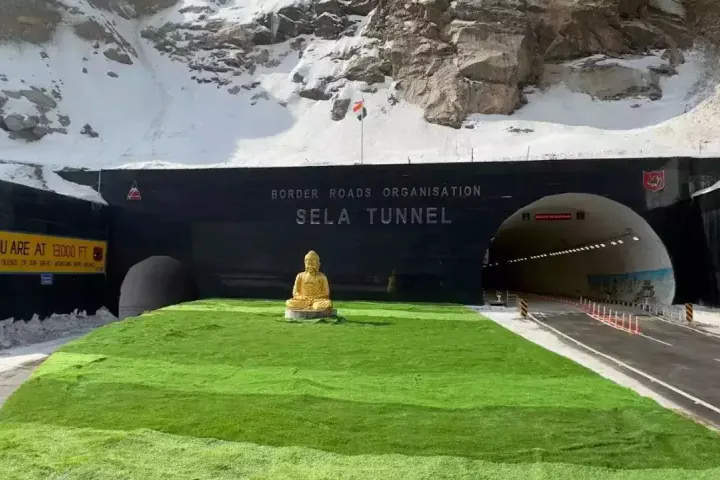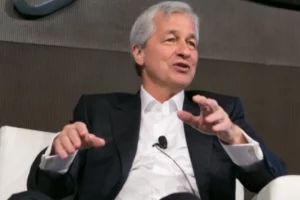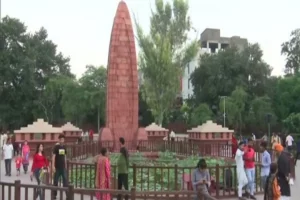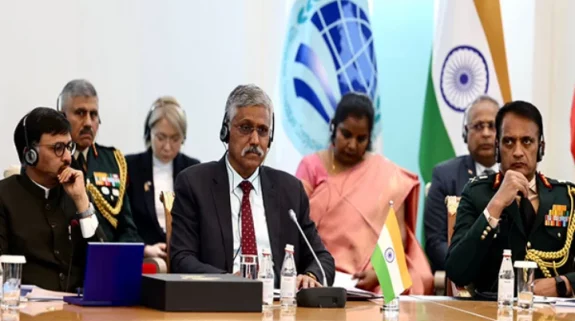Prime Minister Narendra Modi on Saturday dedicated to the nation the strategically-crucial Sela Tunnel, constructed at a cost of Rs 825 crore, in Arunachal Pradesh. It is the world’s longest bi-lane tunnel at 13,000 feet.
The ambitious Sela Tunnel would boost India’s defences and lead to a faster response time for the armed forces to threats on the Line of Actual Control (LAC).
After dedicating the tunnel to the nation, the PM urged the people to visit it and help boost trade and tourism in the region.
“The Sela Tunnel should have been built earlier, but the previous Congress government did not take any such step,” said the PM, who also flagged off the first civilian convoy consisting of two buses from Tawang.
The PM lauded the efforts of the Border Roads Organisation (BRO) in providing last mile connectivity to the border region and for constructing an engineering marvel in such difficult terrain under extremely trying conditions.
Apart from the Sela Tunnel, the PM virtually inaugurated from Itanagar 123 key developmental projects and laid the foundation of 95 new projects worth Rs 55,600 crore in six northeastern states — Manipur, Meghalaya, Nagaland, Sikkim, Tripura and Arunachal Pradesh.
An official said that on the road connecting Assam’s Tezpur to Tawang, the tunnel will enable “all-weather” connectivity to the region and it is strategically significant due to its proximity to the LAC.
The tunnel, stretching through the Sela-Charbela ridge and constructed with the New Austrian Tunneling Method (NATM), will be the world’s longest bi-lane tunnel at an altitude of 13,000 feet.
The NATM is widely accepted and used in construction of tunnels worldwide especially for Himalayan geology.
The Balipara-Charduar-Tawang Road on which this tunnel has been constructed is an important axis connecting Tawang region and provides connectivity to the hinterland, up to Tezpur.
The road had various bottlenecks like Nechiphu, Bomdila Town and Sela Pass, which have been addressed by the BRO by constructing Sela and Nechiphu tunnels and Bomdila Bypass.
The foundation stone of the Sela Tunnel was laid by the PM on February 9, 2019 and its construction commenced within two months.
The tunnel has been completed in just five years overcoming challenges of difficult terrain and adverse weather conditions.
The Sela Tunnel System consists of two tunnels of lengths 1,003 metre and 1,595 metre respectively with an 8.6 km approach and link roads constructed at a cost of Rs 825 crore.
Officials said that the second tunnel also has an escape tube adjacent to the main tunnel as per international norms.
The escape tube constructed parallel to the main tube is connected with cross passages after every 500 metres and in case of emergency this escape tube can be used for the movement of rescue vehicles and evacuation of stranded people.
The tunnel has been designed for a traffic density of 3,000 cars and 2,000 trucks per day with a maximum speed of 80 kmph.
The Sela Tunnel will not only facilitate smoother movement of troops and supplies and reinforce defence capabilities in the region, it will also herald a new era of economic prosperity for the Tawang region, fostering trade, tourism, employment, education and overall development.
Earlier the route to Sela Pass had only single lane connectivity and treacherous bends due to which heavy vehicles, container trucks and vehicles with trailers could not get to Tawang, officials stated.
According to officials, due to adverse weather conditions, specifically in winters, evacuation of patients was affected along the existing Sela Pass. All this will now be a thing of the past with the opening of the tunnel.
The completed Sela Tunnel System will reduce the travel distance by more than eight kms and travelling time by an hour.
The execution of this ambitious project took over 90 lakh man-hours with an average of around 650 personnel and labourers working every day for the last five years.
The enormity of the task could be judged by the quantity of 71,000 metric tonnes of cement, 5,000 metric tonnes of steel and 800 metric tonnes of explosives used for construction.
A total of 162 plants and machinery were dedicated to the construction of this tunnel. Various challenges were faced by the BRO’s Project Vartak during the construction of Sela Tunnel. These included freezing temperatures and formation of icicles inside the tunnel which caused delay in the concreting process.
Ingress of water during construction and cavity formation affected the progress.
However, even with these challenges, the BRO was able to complete the tunnel in less than five years due to the efficient use of technology, ground experience of executives and the hard work of civilian labour involved in the construction.
The tunnel has state-of-the-art safety features and it has a ventilation system to maintain air quality and a world-class electro mechanical system, including jet fan ventilation system, fire fighting devices, CIE norms-based illumination system and SCADA-controlled monitoring systems.




















